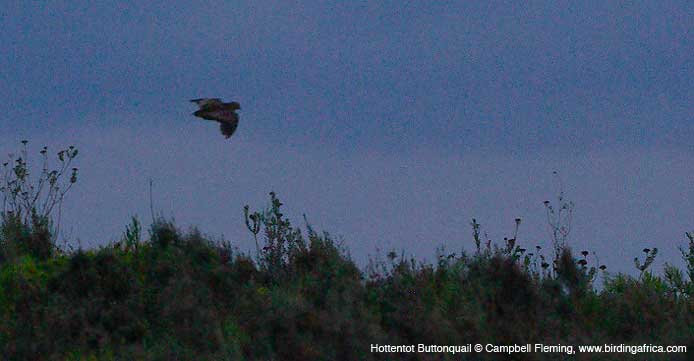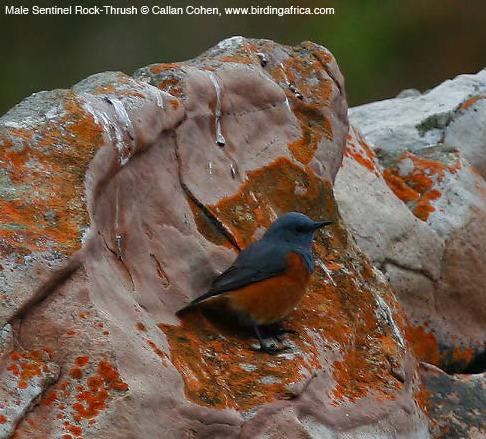Photos with this report (click to enlarge) | |||
 Hottentot Buttonquail |
 Sentinel Rock-Thrush (male) |
||
Summary: On Sunday 21 June 2009, a small group of 6 enthusiasts met in Cape Town with common purpose: to track down a handful of elusive Cape endemics, and perhaps most importantly, to search for the little-known Hottentot Buttonquail. By the end of the day, we had seen no less than 5 Hottentot Buttonquails, surely a record achievement, and we even managed to capture a photo of one! We also enjoyed excellent views of the fynbos endemics: Victorin's Warbler, Cape Rock-jumper, Cape Sugarbird, Cape Siskin and Orange-breasted Sunbird. Raptors were superb, and in addition to three species of accipiter (African Goshawk, twice, Rufous-chested Sparrowhawk, Black Sparrowhawk, twice), and a pair of Forest Buzzards interacting, we also watched a pair of Peregrine Falcons co-operatively bring down a dove against the dramatic mountain backdrop of Rooiels. Close views of a pair of Sentinel Rock-Thrush and Ground Woodpecker were an added bonus.
This Birding Africa trip followed the 4-day Cape Endemics tour from 16 to 19 June 2009 (see separate and fully illustrated Birding Africa trip report.)
The day’s birding started at the Kirstenbosch Botanical Gardens where we met up with Daniel Mirecki, Paul Mostyn and Per Holmen for a day trip to see some selected fynbos endemics and the elusive Hottentot Buttonquail. After a quick briefing, we headed towards the Constantia Greenbelt to search for Knysna Warbler. Reconnaisance trips to various sites the previous week had turned up no Knysna Warblers, and because we were off-season, none were calling again today. In fact, despite 3 hours of checking 6 known areas for the warbler (where we have seen them in previous years), not a peep or a glimpse from a single Knysna Warbler could be detected. Despite being a little chilly at first on this wintery morning, with even a few raindrops, the birding was good. We were able to pick up Cape Siskin for Per (an unusual sighting in the Greenbelts), Cape Batis and African Dusky Flycatcher in the forest edges and a pair of Olive Thrushes scratching about in the undergrowth. We could hear an African Goshawk calling in the treetops and were eventually able to pin down its location and get good views through our binoculars. Our first Forest Buzzard of the day, well spotted by Gordon Botha, was seen perched on a branch before flying off and displaying its underwings. More good raptors included Rufous-chested Sparrowhawk overhead and a pair of Forest Buzzards interacting. Usually a notorious skulker, Sombre Greenbul was seen making its piercing call from an open perch not far from the path, giving fantastic views and photographic opportunities. We stopped in a thickly treed suburban area to investigate a raptor call and Daniel’s sharp eyes picked out the culprit: a melanistic Black Sparrowhawk. Another spot held the beautiful Swee Waxbill.
Once we were satisfied with our forest birding, we made our way to the opposite side of False Bay to chalk up some Fynbos Endemics. We stopped at Rooiels and continued along the coastal path on foot. Here we encountered a pair of Sentinel Rock Thrush (uncommon in the southwest of their range) taking refuge from the wind behind a rock. Orange-breasted and Southern Double-collared Sunbirds roamed the vegetation in search of nectar and at one point, we bore witness to a heated aerial battle between a pair of Cape Buntings. Cape Grassbird was very obliging, perching right in the open and non-breeding Yellow Bishops were also present.
Callan’s sharp ears detected the call of the Victorin’s Warbler (similar to that of Cape Grassbird) and we approached the bush it had called from. After a few minutes of sharp, almost ear splitting calling from deep within the bush, the Victorin’s darted into the open and offered brief but quality views of its plumage (which is rather flashy by South African warbler standards!). A pair of Peregrine Falcons that nest in the cliffs nearby dramatically chased and knocked a dove clean out of the sky! We picked up Cape Rock-jumper among the mountainside rocks and had superb views of a ‘lookout’ male in the scope – another highlight, even for those who had seen the bird before!
We had lunch at the Harold Porter Botanical Gardens and en-route, we saw Ground Woodpecker on lookout duty, perched on a rock. After a delicious lunch, our energy levels were restored and we headed straight to a Hottentot Buttonquail site where Callan had seen the birds reliably before, although we all knew a sighting of this elusive, little-known bird was far from guaranteed.
Imagine our surprise, then, when a bird flushed out of the low fynbos vegetation shortly after arriving at the site! However, while now looking for Cape Clapper Larks in an adjacent area, we could not believe our luck when we flushed a further 4 Hottentot Buttonquails! Despite many years of monitoring the buttonquails in this area, Callan had never seen such a concentration of this species. We eventually had good looks at the lark, and also a stunning Cape Grysbok.
The excitement of seeing Hottentot Buttonquail had left us tired but extremely satisfied after a successful day's birding and we headed back to Cape Town in the light of dusk, arriving back at Kirstenbosch at 19:30.
A Birding Africa Trip Report with pictures taken by Campbell Fleming and tour leader Callan Cohen.
Many of the birding sites on this trip are described in detail in the Southern African Birdfinder which is widely available in South African bookshops and on the internet. (e.g., www.netbooks.co.za or www.wildsounds.co.uk). However you're always welcome to contact us if you're interested in a guided trip in this area: Birding Africa, info@birdingafrica.com, +27 21 531 9148. We are based in Cape Town.
A selection of highlights:
Hottentot Buttonquail
Victorin's Warbler
Cape Rock-jumper
Cape Sugarbird
Cape Siskin
Orange-breasted Sunbird
African Goshawk
Rufous-chested Sparrowhawk
Black Sparrowhawk
Forest Buzzards
Peregrine Falcons
Sentinel Rock-Thrush
Ground Woodpecker